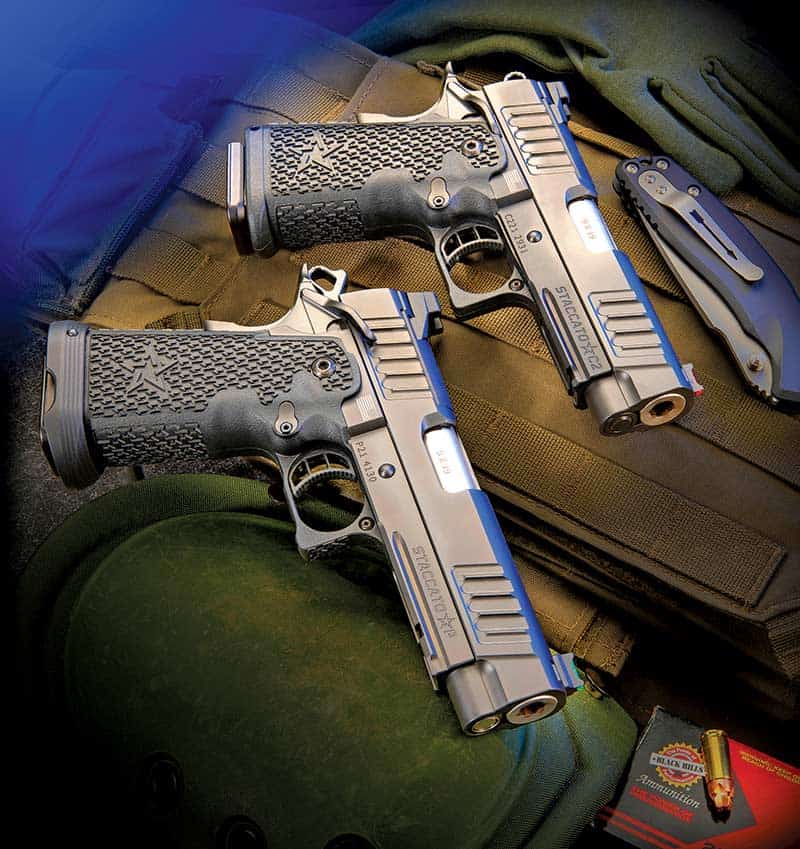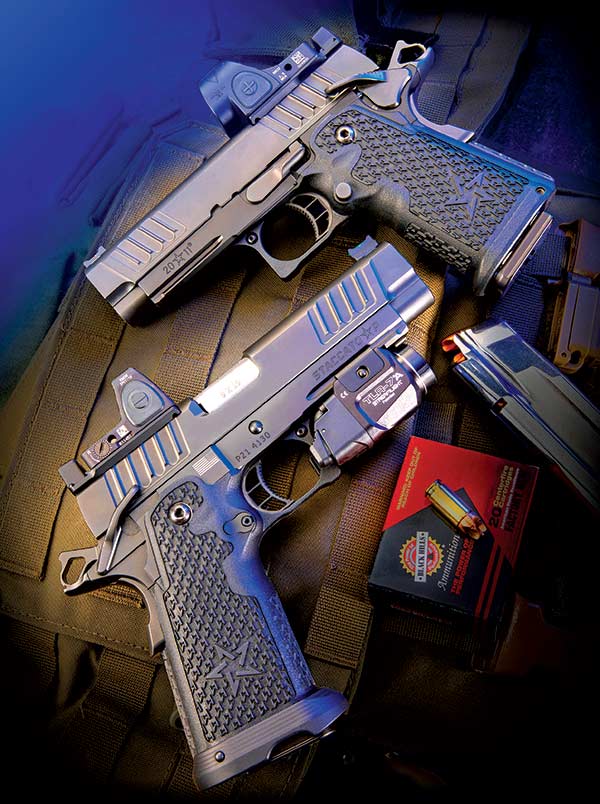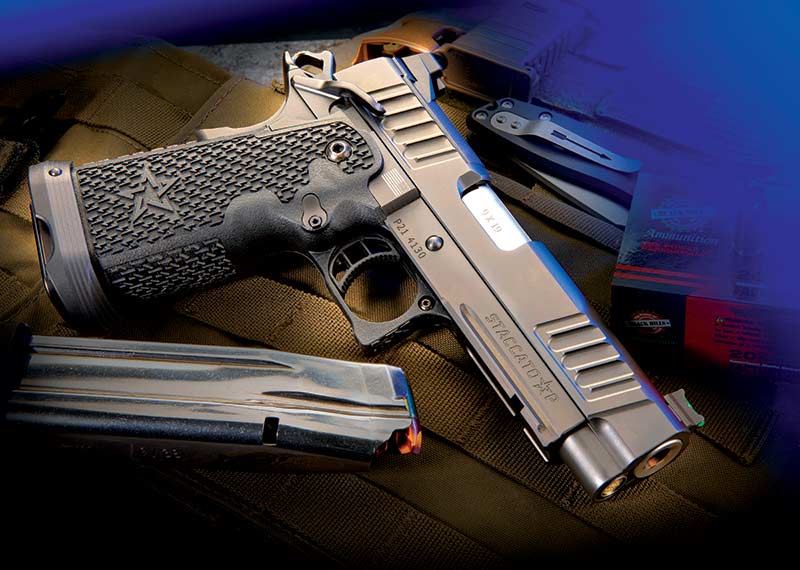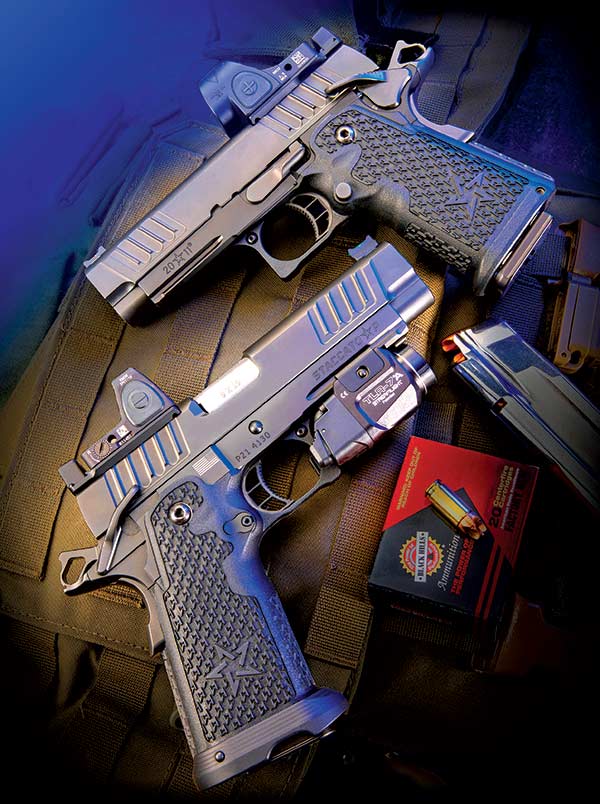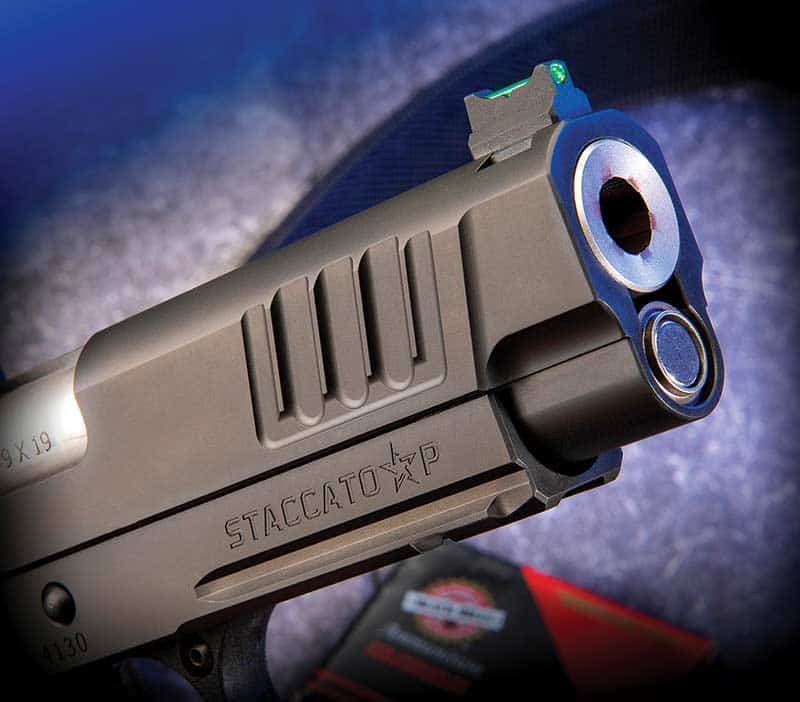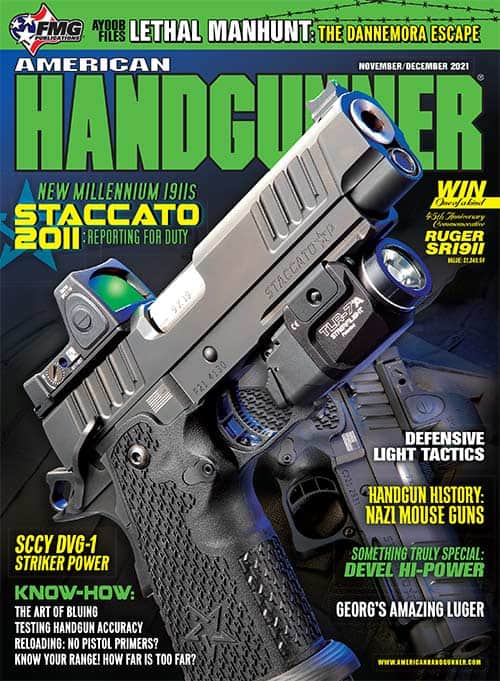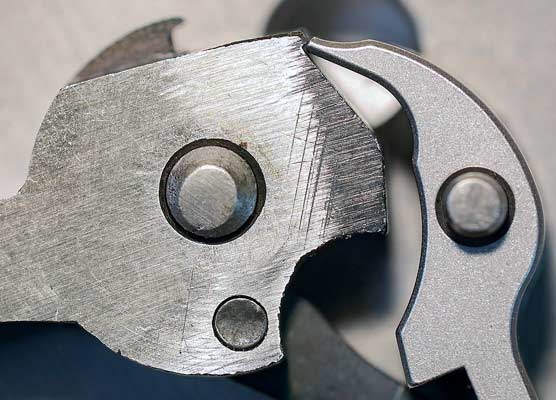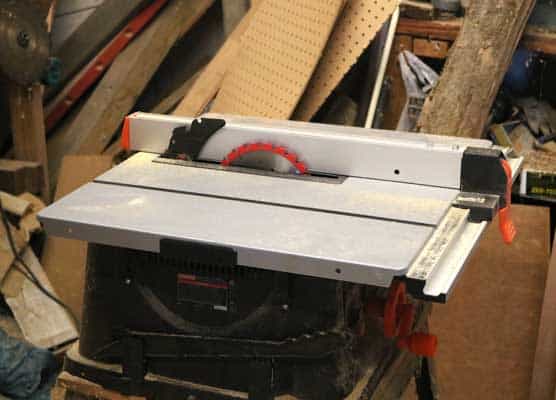Staccato 2011 9MM:
Reporting For Duty
the 1911 Re-Imagined
Handgun competitions don’t teach one how to fight, but they do an excellent job of burning in basic gun handling skills like trigger control, malfunction clearances, magazine changes and the like.
In similar fashion, competition race guns aren’t suitable for duty or carry, but there sure are features and design know-how which should make the leap from competition range to the streets.
The folks at STI learned a thing or two about making next-generation, high-capacity 1911-style pistols to dominate action-shooting sports. Not long ago, the company decided to enter the duty and self-defense markets, leveraging design features and manufacturing techniques applicable to defensive handguns. Fast forward from a re-branding to Staccato 2011, and here we are. Serious users whose day jobs legitimately carry the description “tactical” have been flocking to the Staccato platform ever since.
The reason is simple. The Staccato 2011 combines many of the benefits of the proven 1911 platform with high capacity, reliable 9mm chambering and race gun performance.
The Power Of Hybrid
When you check out these pistols on the company website, you’ll see a bold claim at the top of each page. “The world’s best shooting duty (or ‘carry’ for the C2) gun.” Big words but there’s a lot to back up the claim. When I first shot a Staccato a year or so ago, I was enamored with the easy shooting of the P model. Soft shooting is nice for comfort, but a “cushy” feel won’t save your life. What will is a pistol you can control with ease, even when shooting fast.
The secret to the Staccato’s docile shootability is its three-part design. A classic 1911, and just about every other semi-automatic pistol on the market, is a two “major” part affair, at least on the exterior. You have the lower frame/dust cover, and the slide. Companies mix and match materials on the lower half of the frame to achieve different performance characteristics. Think steel on steel, aluminum and steel, or polymer plus steel.
Staccato threw out the two-part model and went with three. The slide is steel. The frame has been split into separate forward and grip components — metal and polymer. The forward frame is made of steel on the P model and aluminum on the C2 model. The grip module and trigger guard areas are constructed from polymer. It’s this combination of metal for rigidity and polymer for weight savings and flex that make the Staccato 2011s such a joy to shoot. According to company engineers, a high-speed camera will show the grip module flexing under recoil, then springing back forward aiding forward slide movement. Many people find they’ll actually dip the muzzle after each shot, at least until they get used to the surprising lack of muzzle flip.
Trigger And Safeties
Since the beginning, Staccatos have featured a dual construction trigger design, and users love them. The bow is stainless steel. The company considered and tested Titanium but found the stainless construction less problematic and less prone to unwanted flex. The shoe is made from nylon. Yep, that’s right. If you’ve followed the STI/Staccato history, this is no surprise to you, and you won’t find it the least bit unusual. If you’re new to this innovative platform, you might wonder why not steel or aluminum? The simple answer is the nylon/stainless combo just works and feels right. If you prefer, you can pick up an aluminum shoe model from Dawson Precision.
As for the feel, the P averaged precisely 4.5 lbs. pull weight while this C2 worked out to 4.25 lbs. — every time. These pistols are squarely aimed at the duty, concealed carry and self-defense markets, so those weights are spot on. You’ll experience a minuscule amount of pressure-free take-up, maybe 1/32″, followed by less than 1/16″ of steady pressure before a crisp break. Reverse the process for the reset. Maybe a hair over 1/16″ of forward travel will get you there.
Don’t fret about using this pistol for self-defense with its short-travel trigger. It brings all the safety layers of a classic 1911, so the combination of features makes firing a shot a very deliberate undertaking. There’s a grip safety with memory bump that locks the works (the slide still reciprocates) unless you have a proper firing grip. The ambidextrous frame safety locks trigger, hammer and slide until you lower it to fire. For you lefties, there’s no discrimination on the safety — it’s equally generous on both sides, not a lame nod to “ambidextrous” by having something thin and barely operational on the right side of the frame.
Staccato P
al in primary design features but with some selective tweaks appropriate for a larger pistol. The lower forward frame is steel, resulting in increased weight over the C2. The bushing-less bull barrel is 4.4″ and the recoil system uses a full-length guide rod. For takedown, the Dawson Precision 4.4 Adaptive Tool-less recoil system guide rod features an inset hinge that’ll hold the recoil spring under tension so you can slide it out to remove the barrel.
The pistol ships with two flush 17-round magazines and an extended 20-rounder. A removable flared magazine well makes reloads effortless.
Overall dimensions are 8.0″ wide, 5.6″ tall and 1.3″ wide.
Staccato C2
The C2 features a 3.9″ bull barrel, also bushing-less. The recoil system is a bit different, consisting of dual, non-captive springs, so you need to use the included compression lock tool for takedown. Capacity with standard magazines is 16 rounds plus one in the chamber.
The barrel and capacity reduce overall length to 7.5″ long and 4.94″ tall. Width is identical to the P model.
Sights And Optics
Both P and C2 models are available in iron sight configurations or with optics-ready slide cuts. If you order the optics version, you’ll get sights designed to co-witness in the bottom of the sight window. On both the Trijicon SRO and Holosun HE508T-RD X2 I tested, the co-witnessing feature worked like a champ without obstructing the dot.
The rear sight is all black with horizontal serrations and mounts in a dovetail cut in the slide optics plate. The steel front sight is also dovetail mounted and features a fiber-optic insert.
Both pistols feature a single-slot forward rail for additional light or laser attachment options.
Handling
I’m not gonna lie, it was a luxury having both the P and C2 models available to shoot side-by-side. Using the same ammo in both, I was able to tinker and “feel” the nuances of each pistol.
The basic operation, trigger and general shooting characteristics of the two pistols were near identical as one would expect. After all, the operational design features are the same. However, I did notice a difference in “feel” and perceived recoil between the two guns. It isn’t a surprise the P model was the softer shooting of the two, although both guns exhibited the coveted “sights just stay on target” characteristic. I did all the test shooting with red dot sights attached, and the dots just sat on the target, shot to shot. You almost have to train yourself to shoot faster; you certainly can with virtually no sight re-acquisition between shots.
I did the “kitchen scale” comparison of both pistols fully decked out with empty magazines and red dots installed. The C2 with a Trijicon SRO optic tipped the scales at 1 lb., 14.5 oz. The P model with its 20-round and a Holosun HE508T-RD X2 weighed in at 2 lbs., 8 oz.
To be clear, we’re fully immersed in “spoiled rotten” territory here. Both pistols are the softest-shooting handguns I can recall testing, so pointing out differences between the two seems a bit extra. But hey, it’s my job.
The steel magazines drop cleanly, and the release button is crisp, a feature not unexpected from the Staccato 2011’s competition heritage.
Ammo
You know you’ve stumbled across a fun pistol when even during this epic ammo drought, you gleefully raid your precious ammo supply to shoot — a lot. I elected to try four different loads from three manufacturers, and I wasn’t shy about the quantity used. Regardless of what the internet says, gun writers are suffering the same shortages as everyone else these days, so the pain of tossing empty boxes in the range trash bin is real. No matter. I shot this pistol like it was still 2019 using the following loads.
Federal HST 124-grain — In lots of testing over the years, this one has proven to be a stunning accuracy performer. And it’s hard to argue against its defensive performance — expansion and penetration are always right on the money.
Black Hills HoneyBadger — As an all-copper projectile, it’s slightly light for caliber at 100 grains. This translates into soft shooting and low recoil — always desirable features in a handgun. The non-traditional projectile design isn’t intended to expand, so penetration is reliable and steady. The bullet relies on a fluid displacement model somewhat like the operation of a drill bit to establish an effective wound channel. Oh, and thanks to the finicky nature of the Black Hills team, it also features outstanding velocity consistency and overall accuracy.
Norma MHP — The monolithic hollowpoint is designed to be a maximum expander. Also light for caliber at 108 grains, it’s a great solution for civilian concealed carry.
Federal Syntech Action Pistol — This 9mm load weighs in heavy at 150-grains for competition and steel target use. The fat hunk of lead does a swell job of knocking down steel poppers and plates while meeting power factor requirements. The synthetic “jacket” shoots cool and leaves the bore clean — a pleasant benefit.
Difference A Barrel Makes
I wanted to explore the ballistic differences between the P with its 4.4″ barrel and the C2 with its 3.9″ barrel. What difference would the 1/2″ make? I set up a Competition Electronics ProChrono DLX 15 feet downrange and proceeded to launch strings of the four aforementioned ammo types from each pistol.
The P chalked up the following average shot string velocities: Federal HST, 1,153.3; Black Hills HoneyBadger, 1,200; Norma MHP, 1,157.3; and Syntech Action Pistol, 896 fps.
As expected, the C2 with its shorter barrel turned in lower average velocities: Federal HST, 1,111.7; Black Hills HoneyBadger, 1,169.3; Norma MHP, 1,110.3; and Syntech Action Pistol, 885 fps.
To spare you the math, the ballpark “average” is about a 40-fps difference between the two except for the Action Pistol load that seemed less sensitive to barrel length.
Accuracy Olympics
Let the fun begin. With both of these pistols red dot equipped, I figured accuracy testing at 25 yards would be a breeze. And it was. Using my new favorite Ransom Multi Caliber rest, I shot multiple five-shot groups from 25 yards with each of the four ammo types. Since I was shooting two different optics, the Trijicon SRO and Holosun 508, I switched them between guns halfway through the shooting, so I shot each ammo type from each pistol with each optic. While unlikely, I wanted to make sure none of the accuracy results were affected by any difference in sighting.
Starting with the compact C2 model, I shot multiple groups with each ammo type and averaged the results. The Federal HST worked out to 1.93″, while the Norma MHP and Black Hills HoneyBadger printed 1.39″ and 2.0″ respectively. The Syntech Action Pistol surprised at just 1.69″.
The P model shrank those groups, with the Black Hills HoneyBadger winning the day with an average group size of just 0.92″. Hard to argue with that. The Federal HST, Norma MHP and Syntech Action pistol measured averages of 1.39″, 1.29″ and 1.92″.
Here’s the kicker. When I ran the math of all ammo types shot all day, and calculated a single combined average, I came up with 1.38″ for everything fired from the P model pistol. Consider me impressed. I should also note I was probably being limited by the red dots themselves. The Trijicon and Holosun red dots feature 2.5 and 2.0 MOA dots, which cover 0.635″ and 0.5″ of the target at 25 yards. Considering the little bit of dot blur, I have to wonder what a fine-crosshair handgun scope would yield with this pistol.
The Staccato 2011 C2 starts at $1,999 for the iron sight version. The optics ready model sells for $2,299. The P model ranges from $2,099 to $2,399.
For more info: Staccato2011.com


